Stock bike tests are fine and dandy. After all, each and every one-off race machine starts life as a simple stocker before the tweaks begin and personalization and modification take over. In reality, we all could keep our bikes completely stock and roost around as happy as hippos. But we're not hippos, and we're not going to be happy until we mess with every little part of our dirt machines in search of that all-too-often-exaggerated improvement in looks, performance or longevity.In honor of the wrenching code entrenched into our dirt-riding DNA, we invited each manufacturer participating in this year's DR 24-Hour Torture Test to bring a second bike. A cool one. One that would display the gamut of goodies available to those who choose to accessorize. What we received from Honda, Yamaha and KTM will surely put a smile on your aftermarket-buying mug. In fact, when you look at them with a mod-loving frame of mind, even if you have a nearly stock wallet, you might think you're in heaven. But the all-important question remains: Are any of these beasts better than their stock brethren? It's another one of those yes-no answers, so saddle up to the parts counter and get ready for a ride.Whenever you modify something, especially a dirt bike, which is the product of countless hours of factory testing and stock-setting decision-making, you're likely stepping into a push-pull world. You can rarely get something without giving up something else. Top-end improvement is regularly worshiped at the sacrificial altar of low-end grunt. Arm-popping pull and acceleration are often given up for the ease of tractability and smooth throttle control. This is because stock equipment is designed to be very broad. Yes, each brand has its own character and is unlike any other, but, in general, the engineers at each of the factories have a range they build their bikes to suit and they usually nail it.Then the aftermarket comes in with its cowboy-shoot-'em-up types and blows all their hard work out of the water, which, of course, is fine and dandy with us and this test.We did, however, have to keep them corralled a bit, so a few rules were imposed prior to the bike submissions: One, each bike had to begin its life box-stock. Two, it had to have a final sticker price of no more than $9000 (including the base MSRP and all modifications and parts cost). Three, it had to pass a responsible 96-decibel sound limit and come equipped with an approved spark arrestor. Other than showing up for 24 hours of abuse, that's all the builders had to do before we tested the beans out the modified machines. Let's get to it.We'll begin with the Yamaha WR250F because, as a package, the White Brothers-tuned bike is by far the most extremely modified in this test. Starting from the inside out, WB teamed up with CP Pistons and Hot Cams to build a ripper of a motor. The 13.5:1 piston, combined with a set of Stage 1 YZ-F cams (intake and exhaust), definitely picked up the ponies of the blue bike. And when piped with the White Brothers E2 exhaust, the package was totally race tuned-literally. With a quick-building power, the WR really liked riding high in the rev range. It was clear that lugging it around through the bottom wasn't how it wanted to run. There, the bike wasn't jetted as cleanly and didn't pull like it did in the mid to top. We cleaned up the bottom a little with a fuel-screw adjustment, but the bike was still happier up top. It's important to note that this piston and cam setup runs great on pump gas-better on race gas but really good on the pump stuff.This bike was a grip-and-rip sort of ride, with power delivery on the abrupt end of the spectrum, for sure. For all-out racing or wide-open desert trails, this type of delivery is quite desirable and a lot of fun. The modifications aren't aggressive enough to warrant any longevity fears, and the fast-paced nature of race situations will marry well with the companies' simple motor upgrades. On tight trail sections, this type of power isn't the best. It simply goes too fast too quickly to allow your momentum to be used efficiently. You'll catch yourself overshooting corners and breaking tape more often with a motor like this if you ride a lot of twisties.
In the suspension department, the WR wasn't nearly as modified, and it showed. The stock off-road valving was quickly taxed, then bullied by the faster pace the motor wanted to go. This is simply because the bike is going faster than it does when stock. In the world of compromises, leaving out a piece of the motor mod and improving the suspension would make more sense as a complete package. In this trim, the bike blows through the stroke quickly, making it less reactive when pushed on the trail. It wanted more damping everywhere and could probably go with stiffer valving and springs all around if it's going to be going this fast.Protection on the Yamie came from Works Connection's and Pro Moto Billet's brake system armor and Cycra Racing's Composite Probend hand guards. These additions were not over the top and are considered worthy additions to a serious off-road bike.The lighting setup for night riding was provided by Baja Designs' popular Diablo HID kit. Along with a rewound stator and a rectifier/regulator kit, the Diablo upgrades the bike's already-good stock headlight and makes it great for events that are run more than half the time in the dark.When ridden on the trail back to back with a stock Yamaha WR250F, the motor on this modified bike really stands out. It shows how strong the blue powerplant can be and, for the right terrain, how much faster than the competition it can go. However, the suspension is the same as stock and worsens when you go this fast. Throw some aggressive suspension valving in this new chassis and knock one step out of the motor and you have yourself a class killer.Next up via the modified factor is the Precision Concepts-built Honda CRF250X. This bike brings a whole bunch of Baja experience, some serious off-road attitude and a pile of modifications to the testing table. With a mostly stock motor, the X maintained its middle-of-the-road greatness but saw just enough improvements to give it an aggressive streak. The mods were simple and were all part of the Precision Concepts Closed-Course 250X package. Take a stock 250X, install a Precision Concepts air-injection block-off kit and a Pro Circuit 496 muffler, remove a bit more than the snorkel out of the airbox and jet it to perfection. That's it. With this setup, your 250X should run identically to our test bike. And that will make you smile from ear to ear. While maintaining the excellent tractability of the stock X, this modified version enhanced all of its strong points without giving much, if anything, up. The nice, strong midpull was boosted, and the bike revved out reasonably well into the next gear. When ridden in tight, loose or gnarly terrain, the bike stays mellow but strong enough to power out if need be and is the only bike to pull strongly through initial throttle roll-on without clutching.The money Honda saved in motor mods it invested wisely in suspension and chassis setup. And as we reported last month in our stock bike comparison, the setup of the suspension was the weakest link in a very strong stock CRF-X. The bike's Precision Concepts suspenders were more than capable of tackling the gamut of off-road obstacles. The bike wasn't the fastest, but thanks to its great handling, you could easily go the fastest on it. Improving upon the confidence-inspiring suspension was a great control layout, featuring a BRP top triple clamp and bar mount setup complete with a Scotts stabilizer and a Renthal Twinwall bar. The ergonomics and geometry of this array took the stock, heavy-steering feel out of the CRF-X and replaced it with a precise, agile and planted feel. It's perfect.Battling the rocks and sticks of the off-road world is a skid plate's job, and this Honda had a great one. It's a new unit built by Hyde Racing, and we think we'll be seeing a lot of it in the future. It's composite, so it won't affect the flex of the bike's frame and it's definitely tough. Also, a BRP chain-guide block, SealSavers and Acerbis Uniko hand guards were on board to keep other nasties from ruining our riding day (and night).
The stock Honda headlight isn't worth a whole lot because the ignition has a hard time powering it and charging the battery. Even when revved, it's dim. When tweaked with a stator rewind from Baja Designs, it works much better. Bolt on a Diablo kit with the now-standard rectifier/regulator and you've got the dark handled. This kit shined just as brightly on the Honda as it did on other identically equipped bikes.Compared with the stock X, the modified Honda simply improved on all the model's shortcomings and greatly enhanced its strong points. If you're going to improve a bike, this is how you do it.Last on the tuning block is the lightly modified but highly fashionable KTM 250 XC-F. By taking a simple approach to improving its ride, KTM teamed up with its own Hard Equipment in-house parts department and built a rolling display vehicle of anodized goodies. With the old intent of the 24-Hour Torture Test set on testing (and reaching) a bike's breaking point, this isn't exactly a bad idea. If you leave a bike's engine stock (very durable, especially these KTM motors), add on control upgrades, place body armor on every weak link and snap on some pretty parts for good pictures, you just might come out of the Torture Test smelling like a rose.The only modifications to the power-producing unit inside the only steel frame in this test were an FMF muffler and some jetting work. While the FMF Q2 muffler brought this bike into compliance with the sound and spark patrol, it does nothing new to a now-predictable motor. This bike still takes its time off the bottom and pulls well into the mid, and just about the time the upper-mid comes around, it climbs out of its lazy slumber and steadily blows everything else away. I wish there were dirt bike drag races, because I'd bring this bike to the show and win all day long. What the bike needs is some bottom-end; it needs a little something down low to keep the bike from suffering from its finicky jetting and to bring it into the realm of Honda's or Yamaha's broad usability. You can race the beans out of this bike and do quite well, but you'll be working yourself and the bike harder to keep ahead of the competition. The good news is the bike can take the punishment and actually likes being ridden hard, as we've seen nothing but strength in these machines from their clutch plates to their piston rings. Can you take it? That's the question.We mentioned some finicky jetting before, and the XC-F models of KTM's '07 lineup are suffering from a problem. When new, they like to run with their stock jetting right out of the box but with the W's needle (OBEKT) for spark-arrestor riding. Then, around the 10-hour mark or so, the bikes undergo an attitude adjustment and, like teenagers dying their hair color, decide that stock "XC" jetting is the way to go. Call it break-in. Basically, you need to start with OBEKT-third and then switch to OBETP-fifth when the bike gets some miles under its belt.The suspension on the mod KTM was delivered to the event stock as well. And as you've heard before, it's more than decent and versatile this way but could really use a fix. The initial stroke is haunted by a harshness that doesn't affect the handling but really taxes the hands. The KTM front end will have you feeling more of the trail, and that can be more than you want to feel. This is an acceptable compromise for some as the bottoming resistance and movement throughout the rest of the stroke is capable and smooth. Plus, owners generally get used to the extra jolts quickly.Lighting up the night is sort of silly on the KTM considering it doesn't come with a headlight but produces plenty of juice to run a great light setup. So the company bolted on a stock E/XC headlight (just as our stock bike was allowed last month) and added the awesome HellFire HID light kit from NiteRider-a solution more than adequate and a little less expensive than the Baja Designs route.Nothing was more changed, though, than the Katoom's looks. It had striking graphics and a cool vibe around it thanks to orange anodizing found on almost every part, moving or not. That is either of no importance to you or worth everything to you, depending on who you are. We like a pretty bike as much as the next guy but really like them when they knock our socks off on the trail. The modified KTM didn't, and that's sort of a compliment. Why? Well, KTMs come with a lot of trick stuff already. And their ergos are pretty well dialed, and their chassis work well, too. When compared with the same bike stock, this bike is almost identical-just more expensive. So to bust the flattery, we'll just say we would have saved the anodized stuff for later and bolted on some low-end power and a revalved fork first.Precision Concepts Honda CRF250X Weight (ready to ride, tank full): 259 lb Ground clearance: 10.5 in. Seat height: 34.5 in. Footpeg-to-seat distance: 20.8 in. Sound: 91.7 db
||| |---|---| | Part Description| Price| | Fork revalve| $179| | Shock revalve| $179| | Fork oil| $15.59| | Shock oil and nitrogen refill| $11| | Main jet: 138| $6.99| | Pilot jet: 45| $6.95| | Needle: NCVT clip in 4th position| $20.76| | 1x International AIS block-off kit| $39.95| | Pro Circuit 496 muffler| $474.95| | BRP chain-guide block| $74.95| |BRP top triple clamp and bar mount; Scotts stabilizer and bolt-on tower; Renthal Twinwall bar, 997 bend| $639.95| | Acerbis Uniko hand guards| $39.99| | Baja Designs stator rewind| $120| | Baja Designs Diablo HID headlight with rectifier/regulator| $440| | Hyde Racing skid plate| $99.99| | SealSavers| $19.99| | 2007 Honda CRF250X | $6599| | Total project cost| $8968.06| KTM Hard Equipment 250 XC-F Weight (ready to ride, tank full): 257 lb Ground clearance: 10.1 in. Seat height: 36.8 in. Footpeg-to-seat distance: 20.6 in. Sound: 93.0 db
||||
|---|---|---|
| Jetting Specs| Stock| Mod|
| Main jet| 168| Std|
| Leak jet| 70| Blocked|
| Pilot jet| 40| Std|
| Needle| OBETP*| OBEKT*|
| Clip position| 5th| 3rd|
| Fuel screw position| 1.25 turns out| 1.5 turns out|
| * The OBETP works best when the bike is broken in. |
White Brothers Yamaha WR250F Weight (ready to ride, tank full): 266 lb Ground clearance: 9.0 in. Seat height: 36.5 in. Footpeg-to-seat distance: 20.8 in. Sound: 90.5 dbRadar Runs
Once again, we brought our favorite toy-the radar gun-to a comparison. Why? Well, mostly because we like shooting the radar gun and telling our friends how fast bikes go, but it's also a great comparison tool. As you can tell by looking at the runs below, each of our 24-Hour modified 250Fs is unique. Sure, we had them undertake a motocross-style start to show where the bikes are making power and, more important, traction.Right away, you'll notice a tall orange line. That's the KTM. No big surprise there. In fact, the KTM would be the smart money for almost every holeshot, and if you need a good start, the KTM is a good place to, well, start. The softness of the bottom-end helps the bike with traction down low and gets you to the motor's launch point effectively. Then it pulls away, killing everything in sight until the Yamaha finally catches up around 70 mph.Speaking of the blue bike, did you notice how steep that line is? That's aggressive acceleration from a powerful motor. The bike is the slowest on bottom, not because it isn't making power, but more so due to the rear wheel spinning like crazy. A YZ and WR mixed-breed is snappy for sure and, once under control, a pretty wild ride.The Honda occupies the middle road. The modified X pulls great off bottom and through the mid, then tapers off consistently and smoothly. It doesn't fall on its face at all, even though, when compared with the other two fire-breathers on this chart, it seems to do just that. The great part about this power is you can short-shift and grunt around at speed with enough pull to loft the front or jump out of trouble. For long hours on the trail, this is hard to beat.The Winner
Stock is sweet. That's a mantra we Dirt Rider editors chant throughout our days of testing and tuning the world's most advanced off-road machinery. It's not that we don't enjoy the addition of a fair amount of anodized shiny stuff. Nor do we fear aftermarket engine mods on high-revving four-strokes or run away from custom-built suspension systems. We know they can last and are improvements over stock when done right. As we constantly push products and our own bodies in the name of testing, we find, more often than not, that the stock bikes shine just as brightly, especially when tested by a group rather than an individual. That's primarily because of the give and take inherent in modifying bikes. Modifications, by nature, are akin to individualization. And that was obvious here.The WR250F took a motor that was strong all around and built a race-bred beast of a ride. It will rip up top and is a blast to ride but suffers down low and pushes the stock suspension over the edge. The KTM already looks good and looks even better in this polished version. But we were really hoping to ride an improved 250F from the Orange crew, and we got essentially the same thing. Someone show us some more bottom and a smooth transition to the upper revs. The exception here is the Honda. Precision Concepts and its choice of aftermarket companies put together a better-than-stock bike in every sense. It handles better, it runs better, and it looks better. And it will keep working this way in our testing fleet as long as the company lets us keep it. That makes it a winner in our book.
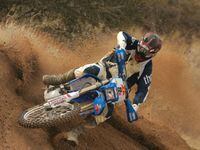
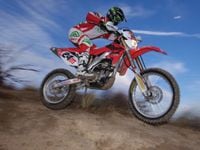

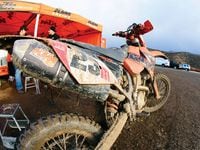
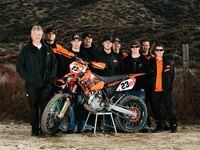


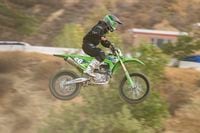
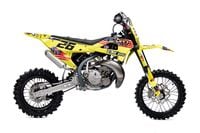
/cloudfront-us-east-1.images.arcpublishing.com/octane/4M2SRDUFDZF6XFPZL7IYESHDC4.jpg)
/cloudfront-us-east-1.images.arcpublishing.com/octane/JMCDU47IXNAABEK3HT7255TFSU.jpg)
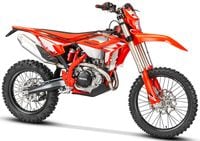
/cloudfront-us-east-1.images.arcpublishing.com/octane/ETCSEDWJV5BGXGHEZFINNZGLMA.jpg)
/cloudfront-us-east-1.images.arcpublishing.com/octane/MD56OW3SRRCBJFWV5F36BOZYUE.jpg)
/cloudfront-us-east-1.images.arcpublishing.com/octane/D3GB6FLJVVDDVCJPJR3ZG276DI.jpg)
/cloudfront-us-east-1.images.arcpublishing.com/octane/PXDBJAHBNFHIPIII2RETRYIHV4.jpg)
/cloudfront-us-east-1.images.arcpublishing.com/octane/IP7MOVDXWFCGJH5HQHH4T44UJI.jpg)
/cloudfront-us-east-1.images.arcpublishing.com/octane/Y4EZFRIEQRE7ZFINGRA2ONFGGQ.jpg)
/cloudfront-us-east-1.images.arcpublishing.com/octane/UIVE2WGHJRCGNLMDXYO2YR27PA.jpg)
/cloudfront-us-east-1.images.arcpublishing.com/octane/XVCN7KNMTFDHZMKMCH5DU5YZRU.jpg)
/cloudfront-us-east-1.images.arcpublishing.com/octane/DTPGQUZAIZAZNPRXG4V6QATIVM.jpg)
/cloudfront-us-east-1.images.arcpublishing.com/octane/Y7EYU3ZTTJFLZEA75REMWWBLSQ.jpg)
/cloudfront-us-east-1.images.arcpublishing.com/octane/TGSYZNI7UVEI7K7ULLVVQ324A4.jpg)
/cloudfront-us-east-1.images.arcpublishing.com/octane/XGKGRRHXPNDRBGPCV4FUAARLRE.jpg)
/cloudfront-us-east-1.images.arcpublishing.com/octane/4MNSJWN6UFEMTDQHVLM52C3X44.jpg)
/cloudfront-us-east-1.images.arcpublishing.com/octane/U6X2X4HGPNCYTNMPYOAN4IIJ5Q.jpg)
/cloudfront-us-east-1.images.arcpublishing.com/octane/B6ZIPVYSKVA3LHDJTGAEEMN4VM.jpg)
/cloudfront-us-east-1.images.arcpublishing.com/octane/I24MVSJBNZDALNIYUHHPVFWNZM.jpg)
/cloudfront-us-east-1.images.arcpublishing.com/octane/SIAXQ2ZOPNBYBLPKJPCHIYGG6A.jpg)
/cloudfront-us-east-1.images.arcpublishing.com/octane/2K6UXOH6I5E4HBKQVMPKA74RR4.jpg)
/cloudfront-us-east-1.images.arcpublishing.com/octane/B52ZU5WMNVF4FDYDONLARN26VU.jpg)